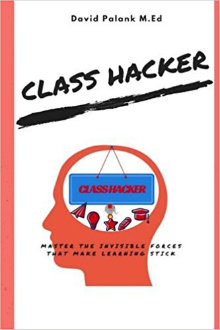Invisible Forces That Make Learning Stick
Class Hacker: Master the Invisible Forces That Make Learning Stick
By David Palank
(CreateSpace Independent Publishing, 2017 – Learn more)

I had a hard time picking this book up to read, mainly because the title includes the word “hacker,” a term with a troubled past. I would hate to see this book not get into the hands of teachers who might most benefit from the instructional changes Palank champions because they weren’t familiar with his cutting edge meaning of the term.
That said, David Palank’s Class Hacker is so enthusiastically and conversationally presented and informative that I enjoyed it thoroughly. The research is also current and the many references excellent.

Brain and Happiness Research
Chapter One begins by explaining the two types of brains (“Paul’s” brain and “Jimmy’s” brain) and how our brains work more efficiently when happy (31% better). This is why positive feedback and generating connections (our brains are “connection machines”) and associations are so important.
Palank summarizes, in steps, some of the brain and happiness research coming out of Berkeley and recent books (Achor’s The Happiness Advantage) and studies. At the end of this and all chapters, there is a bullet list of what to “Keep in Mind.”
Chapter Two discusses students’ ineffective study methods. Most students study by re-reading the chapter or highlighting, neither of which does any good because they are “cursory.” Students need to think about material. Read why practice testing and quizzing beats studying. Learn fun ways for students to study and how teachers can help (answer the first couple of questions on a test). Learn why having students correct their own papers is more than a time-filler and the 3 X 10 Technique.
System 1 and System 2 Thinking
Chapter Three covers the difference between System 1 and System 2 Thinking and what the preferable System 2 requires. Learn why the most creative kid might be the least liked and how bias rubs off and then becomes a threat. Don’t think you’re biased? “If you have a brain, you are biased.” You can’t eliminate bias but you can mitigate it.
Palank’s discussion of Angela Duckworth’s controversial studies on “grit” may make you reconsider her stance. He ties her work into System 1 and 2 Thinking. Seeing people as “geniuses” is System 1 thinking. Successful people use metacognition, System 2 thinking, and it can be developed.
Also read about “Goldilocks Thinking” in Chapter Four and why teachers should begin lessons with the end in mind and assess at the beginning of lessons. Did you realize that testing your brain helps improve memory even if you get the answers wrong? Learn about the concept of “Premortem.” Read about what “Exam Wrappers” are. Palank provides models for daily goal sheets for students. He suggests weekly journals with prompts so students can reflect on their thinking.
Gaining Students’ Trust and Buy-in
Chapter Five talks about the “Science of Trust” and why some TED talks go viral. Learn about “thin-slicing” and what makes teachers credible. It is not graduate degrees or years of experience. Learn “The Four Horsemen of the Apocalypse” behaviors of teachers, why humor is important, and about “The Power of Hands.”
A chapter on “Focus,” Chapter Six, shows ways to get students’ attention and buy-in, including novelty, emotion, and contrast. Learn about the “Picture Superiority Effect” and why the best Ted Talks have no bullet points in the PowerPoint.
Once you have students’ attention, read Chapter Seven which talks about engagement in learning. Learn why simply being “on task” is not sufficient and how emotion drives cognition. Chapter 8’s focus is on “Certainty” and how to build it. Learn why challenge stress is good, and chronic stress bad.
Understanding Rewards and Relatedness
Chapter Nine, “Status,” talks about why rewards (even money) don’t work. Learn about how we learn by teaching and why it’s good to let students teach each other. Here it is important to note that there might be conflicting studies out there. Some believe the worst thing a teacher can do is to use a student as a teacher.
Palank also believes that punishment should be immediate. Love and Logic says it doesn’t need to be. Some of this information a teacher will have to decide on for him or herself. Learn why Palank likes and gives a sample lesson using the Cooperative Learning strategy, “Jigsaw.” The reader might be surprised to learn why Palank suggests using mirrors in your classroom.
In the chapter on “Relatedness,” Chapter Ten, the reader might learn some new information on the results of bullying and how friends protect our emotional health. He suggests “Dialogue Circles” to create a sense of belonging. Learn about “Psychological Reactance” and consider that “Teens have less control over their everyday life than felons in prison,” so therefore give choices (Chapter Eleven). Find out why the new trend of “Genius Hour” is good. Learn about how we all need a sense of purpose and how doing even small things for others, like opening a door, reduces stress.
Chapter Twelve, “Progress” shows how even the illusion of progress motivates people (“Endowed Progress”). So, celebrate often, even small wins. Learn why “Chunking” works well, and don’t overload your students with commands. Learn a simple technique to get more students to finish homework.
Poor Editing Lessens Impact of a Good Book
I don’t think there is anything in this book teachers can’t benefit from, and I like Palank’s enthusiasm. As I read the book, I noticed some words left out and punctuation errors, perhaps because it has been self-published without several sets of eyes looking it over in the form of a critique group or professional editor. In addition, there are two chapter twelves.
I hope he will take the time to correct technical errors and put a more polished version into production so that the many readers who might shut down when they see poor proofreading won’t miss out on his research-based, current, practical information that can help transform their classrooms and the lives of their students.
Dr. Mary Langer Thompson’s articles, short stories, and poetry appear in various journals and anthologies. She is a retired school principal who now writes full time. Visit her Amazon Author Page.


































